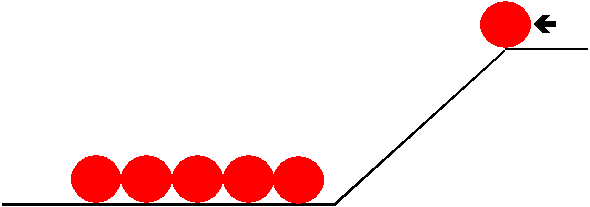Piaget's Colliding Balls Puzzle

A row of red balls is sitting at the botom of an inclined ramp.
At the top of the ramp there is another ball.
What happens when the released ball comes down the slope, and collides with the nearest ball?
This problem is best posed using real balls - and not as a theoretical exercise.
Five year old's solutions (after actually witnessing the collision)
When the ball came down the slope the slope, it jumped over the other balls and kept on going.
Eleven year old reports (after actually witnessing the collision)
The ball came down, hit the first, which hit the second, and so on.
The ball at the free end just went on ahead.
If the eleven year old is then asked, "How would you explain what happened to another child ?"
typically the child would reply:
The ball coming down the ramp gave its speed to the first ball, which then struck the second, which
gave its speed to the seoond, and so on,
The second last ball gave its speed to the last, which was then able to go ahead.
According to Piaget, only the child who has reached the formal operation stage of logical thinking can
give an answer sensible to an adult.
Piaget and Inhelder (his major collaborator)
insisted that transition from one stage to another was not something that could be accelerated.
This Inhelder demonstrated to her satisfaction by showing that children trained to
give the correct answer to conservation puzzles, saying "more" as would be appropriate to a "conserver"
when tested as to their preferences in manner such as asking
"Which of these two chocolate bars do you want?"
in fact would exhibit a preference indicating
that they were non-conservers.
But in fact one of Inhelders research students,
Olivier de Marcellus, in fact showed that younger children could have experiences which ennabled
them to correctly (from adult perspective) interpret
the Collision Puzzle.
In his 1973/4 experiment, Olivier de Marcellus asked children to jump on the spot.
After they had jumped, he asked them how they did it. The kids said something like,
"Swing your arms", "gather up speed", the actual word for "speed" used being the French "elan'.
Note that in this "jump" experiment the children were not "told" or taught"
anything -- in proper Piagetian style they were asked their opinions.
de Marcellus found that the kids who had done the "Jump" experiment
were on a later day presented with Piaget's Collision puzzle, they came up with
something like this: "The red ball hit the first and gave its speed ("elan")
to it. And the first hit the second and likewise ...And so to the end, where there was nothing for the last ball to hit so it justwent on".
Such a response, according to Piaget, was an eleven year old's answer.
A contary opinion as to what Becoming an Expert Physicist is about:
QUOTE
Similarly, the drama in a physics class should not come from colliding balls, flashy demonstrations, or playing with springs, air tracks, and pendulums. Granted, these are all important activities. The real drama of physics, however, lies in its ideas. For example the teacher may introduce students to the drama of Newton's Laws in the following way:
For much of history, people had not been very successful at predicting and explaining motion. But Newton, with his three simple laws, figured out how to explain the motion of all observable objects. His laws gave him a vision into the very nature of the universe - which in his day was like seeing into the very nature of God. And with that vision came a magnificent, but terrifying power - the power to explain, predict, and control the world. Since that day, the world has never been the same. Let's take a look at these ideas and see how they might also change our selves, our world.
The teacher is attempting to foreshadow the significance of Newton?s Laws and create anticipation what power is connected to Newton?s Laws and how they have forever changed the world. The drama unfolds as the teacher helps students act on these anticipations.
UNQUOTE
from
David Wong, Michigan State University
and
Kevin Pugh, University of Toledo
Learning science: Experience, ideas, and science teaching:
A Deweyan perspective on learning in science.
Journal of Research in Science Teaching, 2001.
On-line at
www.msu.edu/~dwong/JRSTDewey.doc
